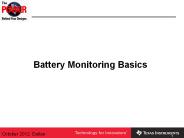Electronics Basics - PowerPoint PPT Presentation
1 / 12
Title:
Electronics Basics
Description:
Chris Miller, Faculty at Heartland Community College. Assisted by: ... In a picture of an electronic circuit, a 'path' is drawn as a line. ... – PowerPoint PPT presentation
Number of Views:20
Avg rating:3.0/5.0
Title: Electronics Basics
1
Electronics Basics
Making an Electronic Light Kit
- Students Involved with Technology
- Presented by
- Chris Miller, Faculty at Heartland Community
College - Assisted by
- Kimberly Travers, Faculty at Heartland Community
College
2
Basic Electronics Terms
- Source (battery)
- Path
- Load
- Light
- LED
- Speaker
- Resistor
- Switch
- Ground
- Capacitor
- Diode
- Transistor
3
Source (such as a battery)
- Picture shows two cells
- When 2 or more cells are combined, the result is
a battery - Measured in volts
- Such as a 9 volt battery
4
Path
- In a picture of an electronic circuit, a path
is drawn as a line. This line represents
connections between components. - In an actual circuit, the path is the actual
connection (typically made with wire or metal)
between actual components.
5
Loads Lights LEDs Speakers
- The load on a circuit is typically where you
can actually see something happen. - The light is on/off.
- The LED is on/off.
- The speakers are silent/not silent.
6
Resistor
- Two types fixed and variable values
- The value of a fixed resistor is shown by the
color coding on the outside
7
Switch
- A switch provides a simple and convenient way of
opening and closing a circuit without having to
disconnect and reconnect wires to a source. - Examples light switch on a wall, power button
on a calculator, power button on a computer
8
Ground
- A ground is a connection between a circuit and
the earth or a metallic object that takes the
place of the earth. - Used to complete a circuit and provide safety.
9
Capacitor
- A capacitor stores electrons until needed (or
until discharged). - Once a capacitor is discharged, it must be
recharged before it can provide electrons to the
circuit again.
10
Transistor
- Transistors are used to amplify and/or switch
the flow of electrons in a circuit. The two
pictures show different types of transistors
can you tell the difference?
11
Ohms Law
- Voltage is represented by an E
- Current is represented by an I
- Resistance is represented by an R
- Voltage current x resistance
- Current voltage / resistance
- Resistance voltage / current
12
Types of Circuits
- Series Circuit(flashlight)
- Parallel Circuit(radio with multiple speakers)































